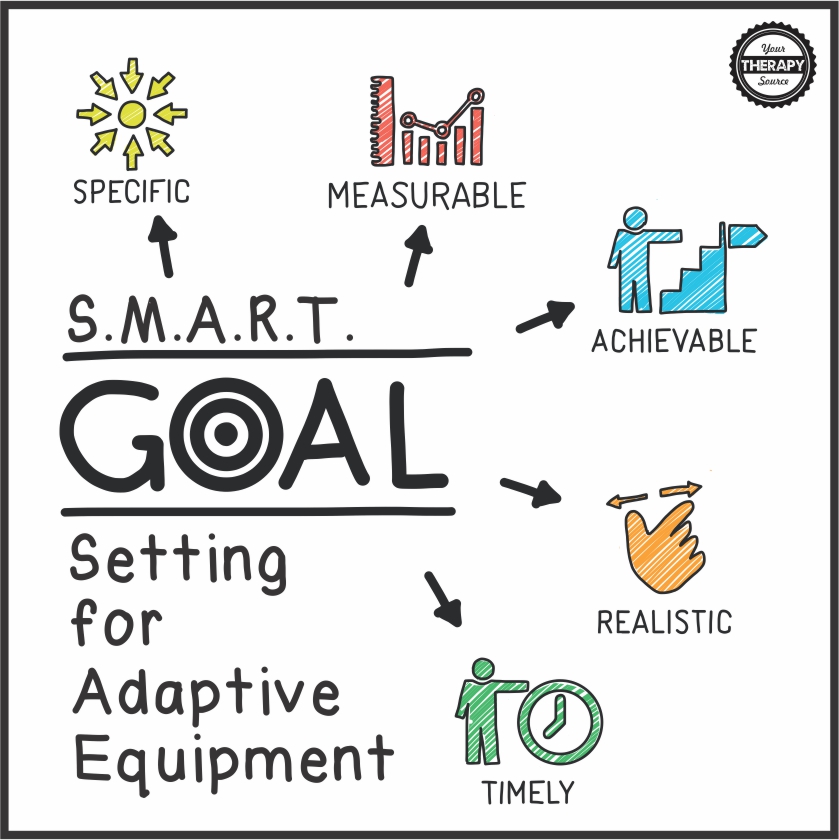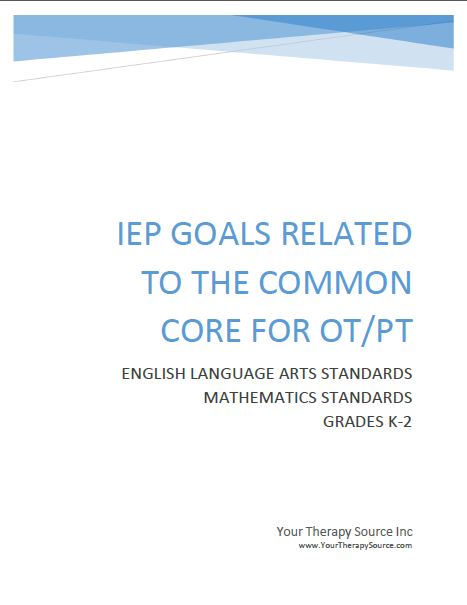Writing SMART Goals for Adaptive Equipment
 Writing SMART Goals for Adaptive Equipment
Writing SMART Goals for Adaptive Equipment
When it comes to the use of adaptive equipment, it is very important to have high standards for goal writing and data collection. Adaptive equipment spans across a huge range from gait trainers to pencil grips with everything in between. How many times have you seen adaptive equipment that was recommended for a student not being utilized properly or to its full potential? It is important to establish SMART goals for adaptive equipment the moment it is put into use. These goals may not necessarily be IEP goals but they need to be written for data collection on whether the adaptive equipment is helping the student to access the curriculum.
When writing a SMART goal that includes adaptive equipment, the therapist or teacher needs to ensure that the goal is:
S – SPECIFIC: what, why and how are you going to use the adaptive equipment
M – MEASURABLE: evidence that the goal will be achieved ie data collection
A – ACHIEVABLE: goal needs to be challenging but reachable
R – RELEVANT: the goal should measure outcomes, not activities
T – TIME-BOUND: deadline that the goal needs to be achieved by
Here are some examples of writing SMART goals for adaptive equipment. Keep in mind that SMART goals that include adaptive equipment may not only be measuring the student’s abilities but also school staff’s abilities to provide assistance if needed.
STUDENT #1 EXAMPLE
Student #1 is able to use a gait trainer with close supervision. One of the student’s goals is to be able to use the gait trainer to occasionally walk during the school day. School staff and therapists will help to encourage the daily use of the gait trainer for functional mobility.
SMART Goal for Adaptive Equipment Student #1
By June 2018, using a gait trainer the student will walk in a class line with close supervision from the classroom to the cafeteria at lunchtime 100% of the time.
S – Specific:
WHAT ARE YOU GOING TO DO? The student will walk in a class line from the classroom to the cafeteria.
WHY ARE YOU GOING TO DO IT? To enable the student to walk with peers to the cafeteria.
HOW ARE YOU GOING TO DO IT? The student will use a gait trainer to walk with close supervision by the teacher, teacher assistant or aide 100% of the time by June 2018.
M – Measurable: This can be measured using observation skills and data collection every day the student walks to lunch at the cafeteria. There is one measurement – did the student use the gait trainer to walk to the cafeteria from the classroom, yes or no?
A – Achievable: Make sure the student has the skill set to accomplish the goal. Make sure that the school staff can provide the close supervision.
R – Relevant: Transitioning from the classroom to the cafeteria is a functional skill during the school day.
T – Time Bound: Student and staff will achieve the goal by June 2018.
STUDENT #2 EXAMPLE
Student #2 uses a wheelchair for mobility. In the classroom, math lessons begin with morning math meeting on the carpet. The student would like to be able to participate in morning math meeting on the carpet with peers instead of the wheelchair. The student requires moderate assistance to transfer from the wheelchair to an adapted chair on the carpet. School staff and therapists will help to encourage the daily use of the adapted chair during morning math meetings.
SMART Goal for Adaptive Equipment Student #2
GOAL: By June 2018, classroom staff will provide moderate assistance to transfer the student to the adapted chair during circle time to participate in morning math meetings 100% of the time.
S – Specific:
WHAT ARE YOU GOING TO DO? The student will use an adapted chair.
WHY ARE YOU GOING TO DO IT? To enable the student to participate in morning math meetings with peers on the carpet.
HOW ARE YOU GOING TO DO IT? Classroom staff will provide moderate assistance to transfer the student to an adapted chair 100% of the time during morning math meetings.
M – Measurable: Collect data on whether the student used the adapted chair during math meetings – yes or no?
A – Achievable: Make sure the student has the skill set to accomplish the goal. Does the student tolerate the adapted chair for the entire math meeting? Make sure that the school staff can assist with the transfer.
R – Relevant: Participating in morning math meeting sitting on the floor is part of the classroom routine.
T – Time Bound: Student and staff will achieve the goal by June 2018.
STUDENT #3 EXAMPLE
Student #3 uses a manual wheelchair for mobility throughout the school day. A mobile stander is available to use in the classroom. During collaborative literacy activities, students in the classroom work standing up and move from table to table. This student requires minimal assistance to transfer in and out of the mobile stander and can independently propel the stander. School staff and therapists will help to encourage the use of the mobile stander to participate in collaborative conversations with diverse partners during literacy activities.
SMART Goal for Adaptive Equipment Student #3
GOAL: By June 2018, after the classroom staff provides minimal assistance to transfer the student to the mobile stander, the student will use the mobile stander to be upright and mobile during collaborative literacy activities 100% of the time.
S – Specific:
WHAT ARE YOU GOING TO DO? The student will use a mobile stander for collaborative literacy activities.
WHY ARE YOU GOING TO DO IT? To enable the student to participate in standing during group literacy activities with diverse partners.
HOW ARE YOU GOING TO DO IT? Classroom staff will provide minimal assistance to transfer the student to the mobile stander in order for the student to be upright and mobile during collaborative literacy activities 100% of the time.
M – Measurable: Collect data on whether the student used the mobile stander during collaborative literacy activities – yes or no?
A – Achievable: Make sure the student has the skill set to accomplish the goal. Does the student tolerate the mobile stander for the group literacy activities? Can the student steer and stop the mobile stander in the classroom? Make sure that the school staff can assist with the transfer.
R – Relevant: Being upright and mobile during collaborative literacy activities is part of the classroom routine.
T – Time Bound: Student and staff will achieve the goal by June 2018.
Student #4 Example
Student #4 exhibits a slumped posture throughout the day during seatwork. A slantboard has been recommended for the student’s desk to increase upright posture, reduce neck fatigue and improve handwriting legibility. The student forgets to use the slantboard frequently resulting in illegible handwriting. The therapist and student have worked together to create a self-checklist as a tool to remember to use the slantboard. The self-checklist has been taped to the desktop.
SMART Goal for Adaptive Equipment Student #4
GOAL: By June 2018, using a self-checklist, the student will remember to use a slantboard during writing assignments 100% of the time.
S – Specific:
WHAT ARE YOU GOING TO DO? The student will use a self-checklist as a reminder to use the slantboard on the desk for writing assignments.
WHY ARE YOU GOING TO DO IT? To enable the student to produce legible handwriting and reduce neck fatigue.
HOW ARE YOU GOING TO DO IT? The student will use the self-checklist as a visual cue to remember to use the slantboard.
M – Measurable: Collect data on whether the student used the slantboard – yes or no?
A – Achievable: Make sure the student has the skill set to accomplish the goal. Can the student view the self-checklist and position the slantboard on the desk?
R – Relevant: Producing legible handwriting is necessary for writing assignments.
T – Time Bound: Student will achieve the goal by June 2018.
Read more on Writing SMART Goals for School-Based Occupational and Physical Therapy.
Read more on Follow Up Questions about Modifications and Adaptive Equipment in the Classroom.
Need more SMART goal ideas based on the Common Core Standards?
IEP Goals Related to the Common Core for OT/PT Grades K-2 – Download of 6 files to align ELA and Math standards for grades K-2 with educationally relevant OT/PT goals. It is a large goal bank for school-based occupational and physical therapy that is aligned with the English Language Arts (ELA) and Mathematics common core standards for grades K-2. It is meant to provide guidance and suggestions on relating occupational and physical therapy goals to the common core curriculum in order to establish educationally relevant goals for a student’s individualized education program (IEP).
The document is divided into six sections: ELA Standards and Goals K, ELA Standards and Goals Grade 1, ELA Standards and Goals Grade 2, Math Standards and Goals K, Math Standards and Goals Grade 1 and Math Standards and Goals Grade 2.
The suggested goals are divided into sections:
- grasp/ manipulation/ fine motor/ coordination
- pre-writing/ writing
- visual tracking/ visual attention/ visual perceptual skills
- adaptive equipment/ technology use
- higher level gross motor skills
- sensory processing
- posture/positioning
- transfers/ transitioning
- mobility
- balance
Get more information on IEP Goals Related to the Common Core for OT/PT Grades 3-5 here.


